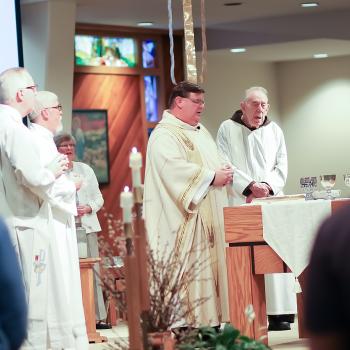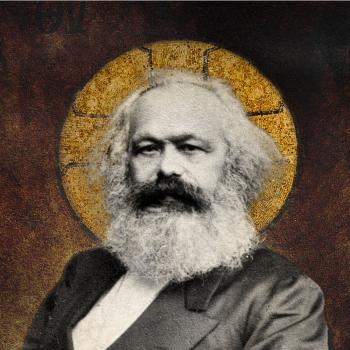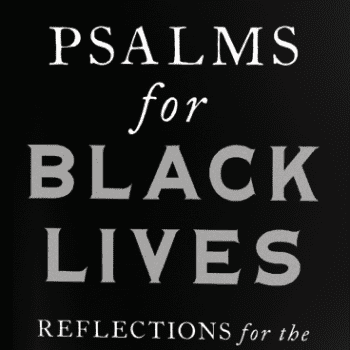Editor’s Note: As I was visiting a few of our Patheos Expert Sites this morning, I came across this lovely post by Lisa M. Hess, a professor of practical theology at United Theological Seminary in Dayton, OH. The post was written during Holy Week, but resonates just as much today. To read more posts from Lisa, visit her Expert Site here.
I seem to have lost my Jesus again.
This may sound like a strange statement, especially during Holy Week, but it is an impending liability for anyone who takes wisdom-walking into resurrection life seriously. After all, if the dead has arisen, if life is ultimately stronger than death, then every apparent truth has a locked opposite within it. Every ‘sure thing’ has a glimmer of uncertainty or possibility to be other than expected. In this way, it’s not all that unusual for a devout Christian to lose her Jesus from time to time. If Jesus is likewise encountered as Cynthia Bourgeault so aptly offers, a wisdom teacher, then such a statement makes even more unknowing but logical sense.
Immersing in kashrut (read more about this current research project of mine here) opened a sensate awareness of G-d’s life in the world, made available to many in the rigorous observance of communally-engaged halacha or law. Jesus as harbinger of freedom from the law both rings true and false now. Why crave freedom from something that has been experienced as life-giving? I’ve lost the Jesus I knew…again. [Yes, Paul undoubtedly is turning in his grave, but his race is run already. He doesn’t have to face the demands and delights of today’s kingdom-work, and as I alluded in a previous posting, his polemic is becoming less and less revelatory. Just because I doubt Paul’s 1st-century vision doesn’t mean scripture is not authoritative…]
Many of my community prefer a scripturally authoritative foundation for legitimation of a statement like “losing Jesus.” If you desire that, turn to Luke and the Emmaus Road, Chapter 24, beginning with verse 13. My summary of it, for this purpose: as soon as you recognize your Jesus in the thanksgiving and breaking of the bread, he vanishes, moving ahead of you to the next place on the path. In that case, Galilee. In my case, I’m not sure. I’ve lost Jesus enough times in my faith journey, however, to trust that he’ll show up again, if and when it’s time. This does not preclude the un-nerving sense of a free-fall, of course.
The first time this happened, I called it a fracture of faith. It was excruciating and I thought my world was coming to a close. Things I had been told became untrue. The community which held these untruths became rigid, unhearing and even unsympathetic of my felt-awareness. I was a second-year seminary student, serving as chaplain at a battered-women’s shelter in New Jersey. A new resident had arrived, fresh with trauma and injury. The social worker invited me into the intake-registration, where I heard the horrific story of a most apparently faithful woman. All she did was give and care for others, and she married a man who not only took all her savings but beat her to a pulp. Afterwards, somewhat in a daze, I walked slowly down the hall and saw my picture on the bulletin board. “Talk to her if you want to find out where God is in your life,” read the caption beneath it. I almost ripped it down. When I arrived back to the privilege of an elitist campus, I realized I had been crying the entire way. I went to the chapel to throw something heavy at the altar, but wound up bumping into an organist friend who was practicing for a recital. She invited me into an acapella singing group, which “coincidentally” wound up being my entire reason for staying in seminary during that year’s paradox of horror and holiness. Almost the whole year, Jesus was lost. Gone. Completely absent. But several months later, a small book called The Power Delusion found me. I read it twice, from cover to cover, in the space of a couple hours while sitting in the chaplain’s office at the shelter. I didn’t understand it, per se, but I knew I wasn’t alone any longer. The fracture was healing, leaving the bone stronger than it had been.
The second time this happened, it was also painful and destabilizing. An impish Sister of Charity in whom I had placed great trust, who had participated in the healing of a deep splinter in my past, was leaving for retirement. A new safety, a personal sanctuary of hope and healing, was closing down right in front of me. I was being pushed out of the womb, she might say. Faith vanished, Jesus was a joke, and I raged at the fear enveloping my world once again. Absence. Free-falling emptiness. Another mentor arrived on the horizon, stepping into the absence for a spell. A Quaker with deep scars and profound healing, both. The intimacy between us deepened beyond anger, underneath my rage. I knew once again that I was not alone. I even received a glimpse that loneliness could be a wise teacher, if one welcomed him in for tea and conversation. The new fracture healed, stronger than before.
I’ve since lost count of how many times Jesus has disappeared in front of me. It’s not that it’s easy or mundane, in felt-sense or lived experience. I’ve simply learned that his disappearance is necessary. Jean-Luc Marion, a Roman Catholic who teaches philosophy and theology at the Sorbonne and the University of Chicago, has a marvelous teaching image for this in his philosophical explorations of icons and idols. Instead of a definite distinction between icons and idols—the first of holy use, the second as profane infidelity—Marion points to human perspective inviting, even imitating, a paradox of the visible/invisáble (i.e. that which cannot be aimed at or taken into view) in the relation between icons and idols. The image for my purposes here is of an “idol” as the “high-water mark of the divine.” In this view, absolutely anything God chooses can become an icon toward holy union. Human perspective and finitude, however, can sustain only so much. Any so-called “icon” becomes an idol when the Holy overwhelms human form/understanding(s) and a human gaze rests on the object or concept through which the Holy was previously received or known. Once we know love in a certain way, we keep returning to that spot to receive it again. Not unlike Pavlov’s dogs, actually. Therefore, unavoidably steeped in this ‘serial idolatry’ as human finitude is, encounter with the Holy (or perhaps we could even say enlightenment) requires the icon–Jesus, in my case–to disappear from time to time.
For one thing, the disappearance reminds me (and any who listen alongside me) that it’s a facile untruth to align “Jesus” with bliss and “Absence” with loneliness or pain. Protestants—they are the ones I serve—easily assume that Jesus vanished at the fractures in my stories, and returned in the intimacies. Cheesy poetry assures us of such things. And it’s too sadistic and morbid to consider Jesus as cause of the fractures. But, refusing the seduction of cause-and-effect thinking, I’m willing to venture forth that Jesus actually broke into my life in the fractures, and eased off on me for my finitude to expand accordingly, in the necessary time and pace of recovery experienced as intimate. Doesn’t that actually make more sense? That any Wisdom Teacher, truly present in relationship, requires more space than frail human forms/minds can remotely hold? How does one learn to hold in both mind and body the greater and greater sized-realities of the sacred? By being broken open, of course. Gently, with great care and compassion, but broken open all the same. [By making a ‘knight’s move’ into more and more inclusive levels of intelligence or awareness in which binaries—even painful ones—are held in awareness at the same time as interdependent, interconnected. Stay tuned for exposition on that image.] So the disappearance of my holy teacher actually teaches me more about him, about myself and this world, the longer I remain within his teaching, in his Body we call the church.
On the other hand, this means I am faced once again with my own felt-uncharted waters during the thin-space time of observance of Holy Week. The felt-sense of presence was regular in observance of kashrut, a heightened intentionality and mindfulness of a new lifeline in the mundane, i.e. a suburban kitchen. G-d’s righteousness moves into human life, communal actions, disdained by Paul but innovated over centuries by the rabbis, their Sages. Christian liturgy—a Palm Sunday one this week—feels strangely absent, impersonal, un-intimate. Foreign and yet familiar. Home, but home at a new angle. I find again that the communal sense-making about Jesus’ crucifixion recedes more and more from my understanding. I can no longer glorify the bloodiness that so many of my community find significant for salvation. I am less and less inclined to worship Jesus, though my sense of him as intimate companion increases steadily over the years as Real. Strangely, because he disappears from time to time, I trust him more than I ever have. Perhaps this is because there’s a felt-sense of presence, showing me something new, which only becomes Real because there is also absence. Or perhaps this is because he’s reminding me that he’s not actually the point, but the path. His divine nature awakens the holy spark within, still flickering and nourished within Christian patristic wisdom. But this One, this week, is not a Jesus I recognize. Yet.












